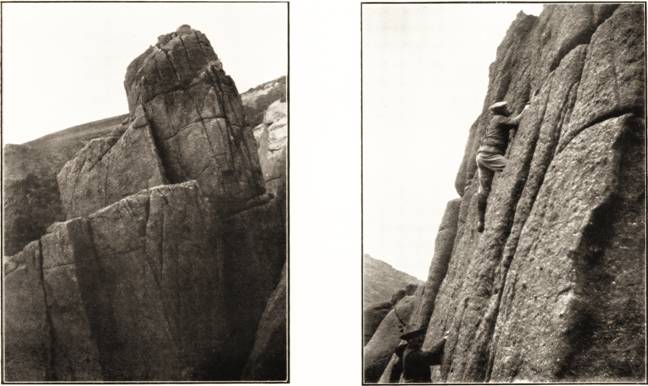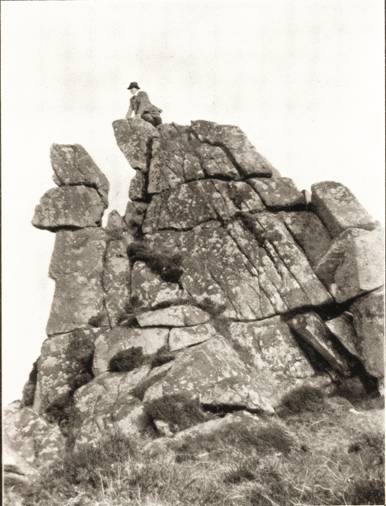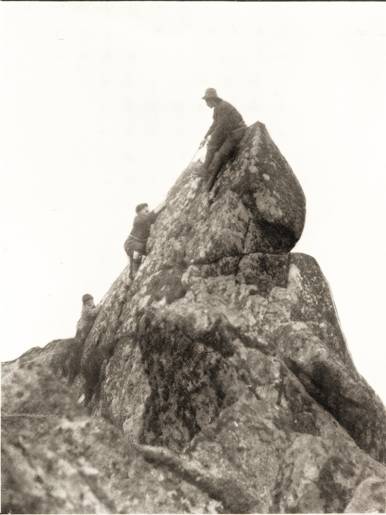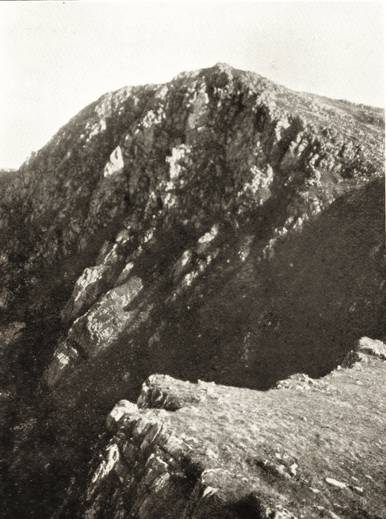Members’ Holidays In 1911
G. Winthrop Young made the most of the wonderful season of 1911, as the following diary of his three weeks climbing shows : –
July 31. – Les Ecrins: first ascent of Dome de Neige by S. face and W. ridge; traverse of Pic Lory and remaining summits (16 ½ hrs.)
Aug. 2. -Traverse of La Meije (8 hrs. 20 min., 6 hrs. 20 min. actual going.)
Aug. 5-6. – Grandes Jorasses: Exploration of E. ridge (21½ hrs.)
Aug. 9. – Mont Blanc: first ascent by the Brouillard ridge from Col Emil Rey over Pic Luigi Amadeo and Mont Blanc de Courmayeur to summit (21½ hrs.)
Aug. 11. – Grandes Jorasses : first descent of the E. ridge to Col des Hirondelles (18½ hrs.)
Aug. 14. – Grandes Jorasses: first ascent of the W. ridge from the Col des Grandes Jorasses (17 hrs.)
Aug. 16-17. – Col du Géant, crossed alone (7 hrs.)
Aug. 19. – Grépon: first ascent direct to summit from the Mer de Glace (16 hrs.40 min.). (See A.J., 3V., and C. C. J., 1912.)
C. R. Wingfield, Whom we congratulate on his election for a second term as Mayor of Shrewsbury, “acquired merit” in December, 1910, by visiting flood-bound cottages in a coracle. In February and March he had a few days skating and ski-ing, and spent part of April at Finse (Norway), where he had some good ski-ing (temp. – 25° Cent.).
At the Club meet at Easter; in training at Ross during June, when he explored some small caves in Symonds Yat; and entertained the Club on the Welsh Marches at Bank Holiday. On the 2nd September sailed on the ” Gwynfa ” to Ostend, Antwerp and back, and on the 7th October motored from Shrewsbury by way of Llangynog, Bala, Festiniog, Beddgelert, Pen-y-Gwryd, Capel Curig, Bettws-y-Coed, Corwen, Llangollen and back to Shrewsbury, 150 miles, 5,600 ft. up and same down.
On the 24th August travelled 25 miles in a balloon with two friends and Mr. Percival Spencer, the aeronaut, at Shrewsbury:-
“At a word from Mr. Spencer we put out pipes and cigarettes, scrambled over the edge of the car and watched the sandbags being unhooked and the men who held the car letting her go and catching her again to test the lift.
“Mr. Spencer had one more bag removed, got another ready to empty on the heads of the assembled crowd, if required, shouted to the men holding the car down to let go, and punctually to advertised time, we shot up from the ground, amidst the cheers of the spectators.
“After the first feeling of lift, there was no sensation, other than of the earth rapidly receding from under us. What struck me most on the whole trip was the vast sea of upturned faces getting smaller and more indistinct every moment and the bird’s eye view of the town with diminutive, fore-shortened people walking in the streets, apparently between the roofs of houses. We passed over the toy-like Railway Station with the narrow tracks diminishing into the distance and came upon the open country, which looked like a chess-board, with narrow-looking roads along which toy motor cars seemed to be crawling. Our height at this time was about 2,000 ft., and undulations of the ground were hardly discernible and woods looked like green flats. It was a glorious day of brilliant sunshine, a few clouds only casting a shadow here and there. The hills with which Shrewsbury is almost surrounded looked smaller but clearer than usual, and so did the Berwyn Mountains, 30 miles distant, but unfortunately I could not make out Snowdon.
“Though we were travelling at about 20 miles per hour, the sensation was only one of drifting slowly in a perfectly calm atmosphere, sounds from below could be heard with extraordinary clearness, and we were able to carry on a conversation with another balloon about half a mile distant.
“After being up half an hour the earth appeared to be getting nearer, and the bits of paper which we threw out fluttered upwards. Our trail rope, about 300 ft. long, was let down, and presently it touched a tree top whose leaves we could see waving in the wind. Then it touched ground, and we descended until about 100 ft. of it was dragging across fields and hedges, and also, to our amusement and the surprise of the occupants, across the roof of a cottage. A woman and dog rushed out, and the latter started to chase us, barking furiously, but soon gave up as we were still travelling about 15 miles an hour, though the friction of the rope trailing had slowed down our speed considerably.
“A bag of sand was thrown out and we rose rapidly to about 4,000 feet, where, owing to the rarefied atmosphere, one’s ears gave a slight click and there was a strong smell of gas as it escaped from the open end above our heads. We attained a maximum altitude of 4,700 ft., and were then drifting amongst some light fleecy clouds which afforded us the amusement of waving to our own reflections. We enjoyed the beautiful effects of sunlight and cloud so well known to mountaineers, and at one time had a glimpse through a hole in the clouds, of the earth far below. However, the increasing cold and damp, and the amount of gas already lost, soon caused us to descend rapidly; we were rather short of ballast and had to accept the inevitable and prepare to land, nor had we much time to spare as the earth was rushing up to meet us. Mr. Spencer took hold of the valve cord and a sandbag, one of the party had the remaining bag ready to drop, another the anchor, whilst I looked on. No sooner did our trail rope touch than there was 100 ft. of it dragging along the ground, which not only checked our speed but reduced the rapidity of our descent, as every pound of rope on the ground was so much less for the balloon to support. A bag of sand was also emptied overboard. Still descending, the car brushed the tree tops of the wood, and we landed under its lee with a slight bump, bounded a few yards and settled quietly to rise no more, the valve at the top having been opened as we touched ground.
“The anchor looked very silly lying on the grass with a lot of slack rope between it, and so did the car. As soon as I was allowed I jumped out to take a photo, but unfortunately before I had opened my camera a puff of wind caught the balloon and turned the car, relieved of my weight, over on its side, but with the assistance of two men it was soon righted and the party set upon their legs again.
As the gas emptied the others got out one by one, trail rope and anchor were undone and made up, the car slings untoggled and netting taken off, the gas bag carefully rolled up, and the whole loaded on to a waggon, which we followed to Whitmore Road Station.”
C. R. W.
G. W. Lloyd, with the Rev. E. A. Aldridge, was in Palestine and Syria from March 25th to April 29th. They first spent a fortnight at Jerusalem, during which time they walked to Jericho by the Wady Kelt (” the Brook Cherith “), the Dead Sea and the Jordan (three days); and to Hebron and back (two days). Leaving Jerusalem on April 6th they walked to Nablous, the ancient Shechem (two days), visiting Bethel and Jacob’s Well en route. While at Nablous they ascended Mt. Gerizim (2,848 ft., i.e., 1,000 ft. above Nablous), and visited Samaria, which is seven miles away. From Nablous they walked to Nazareth (two days) by Jenin, Jezreel, and across the Plain of Esdraelon. Thence to Tiberias on the Sea of Galilee, and from there to Safed by Tel Hum (where it is believed Capernaum stood). From Safed they rode to Banias (Caesarea Philippi), where is the main source of the Jordan. From Banias they rode to Arny, a mountain village (4,500 ft.) at the foot of Mt. Hermon on its eastern side. From there they made the ascent of Mt. Hermon (9,050 ft.) by the rock rib facing Arny, the last 3,000 ft. being more or less over snow (3¾ hrs. from Arny to the top). The next day they rode to Damascus, and from there went to Baalbek and Beyrout, and thence took steamer home, calling at Haifa and Jaffar.
“It is necessary to have a Dragoman. Ours was a young Syrian and rode on a horse. We were also accompanied by another man, who came to look after the horse and bring it back from Damascus: he rode on a mule. These animals carried our rucksacks.
“We generally started as early as we could, from 4.30 to 5.30 a.m., to avoid the heat, and averaged about twenty miles a day.
“The heat was intense at times, especially during our walk to Jericho and the Dead Sea, the latter being 1,300 ft. below the level of the Mediterranean and the lowest spot of the earth’s surface.
“At Jericho, Nablous, Tiberias and Damascus there are quite comfortable hotels. At Hebron we stayed in the Russian Hospice, and at Jifna, which is the best place to spend the night between Jerusalem and Nablous, in the Latin Monastery ; at Banias and Arny we stayed in native houses, sleeping on mattresses placed on the floor, which were quite clean and comfortable. At Safed the Medical Missionary of the Jews’ Society most kindly entertained us for three days.
“As regards food, we took with us tea, sugar, sardines, marmalade, &c., and could always get chickens and bread, but not butter, on the spot, and generally a small quantity of milk. The usual loaves of the-country are flat and flabby, made of barley flour. At Arny the native bread was in thickness and texture exactly like brown paper. It was excellent to eat, and most convenient for wrapping up our lunch in. The water as a rule is not to be depended on, unless boiled.
“The people at whose houses we stayed for the night were friendly and hospitable, but on the whole we were not very favourably impressed by the people of the country.
“Spring is certainly the best time of the year to visit Palestine; the country is then looking its greenest, the flowers are at their best, and there are no mosquitoes. We had only one really wet day (April 13th, when we walked from Nazareth to Tiberias), and a few showers on one or two other days.” (See also A. J., 3VI., 32.)
W. A. Brigg was at Zennor for Easter with J. J. Brigg and Messrs. W. P. Haskett Smith, Eric Greenwood and H. Scott Tucker; at Cwellyn Lake for Whitsuntide with Messrs. Haskett Smith, J. M. Archer Thomson and others; and in Ross-shire for the Coronation holidays with Mr. Eric Greenwood, and Messrs. Garden and Parker of the S.M.C.
“Zennor is a tiny village on the N. coast of Cornwall, four miles to the W. of St. Ives, with limited but good accommodation. There are cliffs all along the coast from St. Ives to the Land’s End, but the climbing is only good where the granite crops out, as it does at Wicca Pool, one mile to the E. of Zennor, and at Bosigran, three miles to the W. At Wicca there is a Pillar Rock in miniature, with a Pisgah – two, in fact. The climbing is from sea level – and sometimes hardly that – on rock quite dolomitic in texture and sufficiently rough to make scarpetti and gloves very grateful. Its clean cut chimneys, perpendicular cracks and delicate traverses furnish many neat problems, but are not set amid such striking surroundings as Bosigran, where we have on one side of the bay a bold stretch of cliff, 300 ft. high, with several climbable routes, and on the other a ridge which springs from sea to skyline in a series of fantastic pinnacles and aretes, so narrow in places that the hand can close across the edge, with rock as firm as wrought iron ; and in the bay between them a narrow island rising some 150 ft. to a summit not unlike that of the Grépon. At both places the immediate -sometimes too immediate – contiguity of the restless sea, Mediterranean in its green and purple limpidity, the wheeling gulls, sentinel cormorants and peering seals make the climbing as different from that in Lakeland or Wales as it is charming. For an off day there are the inland moors with their grey ‘logan’ stones, old world ‘dolmens’ and ‘menhirs,’ worked-out tin mines and blazing splendour of gorse and heather.” Cf. Mr. Andrews’ “Climbing on the Cornish Cliffs,” (C.C.J., vol VII., p. 55), and ” From St. Ives to the Land’s End,” by Folliott Stokes (Greening & Co., Ltd., London).
“Cwellyn Lake lies in the Gwyrfai Valley, on the road from Carnarvon to Beddgelert, and has a small but good hotel, the Cwellyn Lake (formerly known as the Snowdon Ranger) Hotel, close to Cwellyn (or Quellyn) Lake Station , on the North Wales Narrow Gauge Railway.
“Our climbing was done in the lower ranges ‘twixt Snowdon and the Sea,’ a district only now being explored by climbers.
“Cwm Du is a cirque on the N. flank of Mynydd-mawr, with several fine gullies and a curious rock pinnacle, quaintly christened King William the Fourth. Y Garn, at the head of the valley running W. down to Nantlle, has two good ridges, one of steep but sound rock, the other, not yet climbed, of more broken character. It was on the latter that the late Mr. Anton Stoop was killed, and from the other ridge it was easy to see that the accident must have happened by the rock to which he was trusting giving way whilst he was descending a quite short and apparently easy chimney. The rocks are arranged endwise up, like books in a bookshelf, and would not require much weight to dislodge them – a risk to which climbers on unknown rocks are peculiarly liable. The cliffs of Llechog form the W. side of Cwm Clogwyn on the W. side of Snowdon and are in full view of the summit. Two new face climbs, ‘The Mermaid ‘ and ‘The Central Rib,’ were done on its very firm and steep rocks (see C.C.J., 1912, p. 13). Castell Cidwm is a rock buttress at the foot of Cwellyn Lake, with one very steep and narrow chimney.
“The weather was so exceptionally fine that some of the party left their coats at the hotel and climbed Snowdon in fives-shoes.
“Our excursion in Ross-shire was made in the heart of the deer forests, a district now less populous and less frequented than any part of the Alps, and would have been practically impossible without the permission of the lessees, as there are few rights of way and no places of entertainment, except with the keepers and at the tiny inn at Cluany Bridge – the Shiel Hotel has been closed. We motored out from Inverness on Thursday morning (June 22) to Ben Ula Lodge, near the head of Glen Cannich, about 50 miles, and from there ascended Tom a’ Choinich in the wet and traversed along the ridge over Carn Eighe (3,877 ft.) and Mam Soul (3,862 ft.), descending to Alltbeath Lodge in Glen Affric. On Friday we traversed the long ridge from Sgurr A’Bhealaich Dheirg to Scour Fhuaran (3,505 ft.), and slept in Glen Shiel; on Saturday walked round the head of the Allta’ Choir Uaine, climbing the Saddle on the way, and came down to Cluany Bridge Inn ; and on Sunday went back by motor to Inverness.
“There are 283 peaks in Scotland over 3,000 ft., called by the members of the S.M.C. ‘Munros,’ after Mr. Munro, their first tabulator, and it is, I believe, the secret ambition of every good member to climb the lot before retiring. We passed over some twenty-two – I believe Parker bagged a few more in the wet on Sunday morning – and some were really fine peaks, others only, to use the term Dr. Johnson applied to them ‘considerable protuberances There was little or no climbing either on the ridges themselves or on the flanks – our only good scramble was on the Saddle – and the mountaineer must find his pleasure in the far flung ranges, wild corries and quiet glens, peopled only by the deer and the ptarmigan, and in the wide views, that from Scour Fhuaran in particular, embracing, as it does, Torridon to the N., Skye to the W., Ben Nevis to the S., and the Cairngorms to the S.E., is comparable, barring the snow, with any view from the Pennine Alps, looking S.
“The going is mostly over grass and scattered rocks, and the flora in places quite Alpine. One peak, for instance, was cushioned with pink-eyed silene, whilst the quaint lichens and thick moss covering rocks ‘hoary white with eld’ spoke of a moister clime.
“Of the spelling of the peaks on the O.S. Maps I will only say that the surveyors must have had a job lot of letters of the alphabet served out in mistake, and were determined, thrifty souls, to use them up. How otherwise can one account for Ben Ula being spelt Bhein Fhionnlaidh, or Mam Soul, Mam Sodhail? As Dr. Johnson says, ‘Whoever, therefore, now writes in this language, spells according to his own perception of the sound and his own idea of the power of letters’ ” (See also S. M. C. J., XII., I.)
Erik Addyman, J. De V. Hazard, E. E. Roberts, Payne and others spent Easter at Fort William, climbing Ben Nevis by Gardyloo Gully, Aonach Mor and Aonach Beag in seven days continuous rain.
J. M. Davidson, with R. Lamb, started from Modane on July 7th, climbed the Dent Parrachée, Grande Casse, Grande Motte, Mont Pourri and Tsantaleina, and on the Col du Géant met J. De V. Hazard and E. E. Roberts, who had come via La Vierge and the Petit Flambeau.
These three next climbed the Aiguille de Rochefort and Mont Mallet, Dent du Géant (first two only), traversed the Charmoz and Grépon, and climbed the Grand Dru. Hazard and Roberts then crossed the Col de Triolet, which was more difficult than in ordinary seasons, the descent being extremely interesting.
E. E. Robert in the Maderaner Thal (chiefly with J. H. Hollingsworth and W. M. Roberts) climbed the Heimstock, Catscharauls, Dussistock, Oberalpstock, Hohlenstock, (first ascended by W. Cecil Slingsby in 1886), traversed the Klein and Gross Scheerhorn, and climbed the Gross Ruchen by W. ridge (a long rock climb, first done by E. Calvert and T. Gray, of the Y.R.C., in 1897).
“The outstanding feature of the marvellously fine alpine season of 1911 was the warmth of the nights and early mornings. Although the mountains became very bare of snow there was never sufficient frost to turn the snowslopes into ice, so that these remained in splendid condition, being only iced close under the rocks. Bergschrunds became enormous.”




